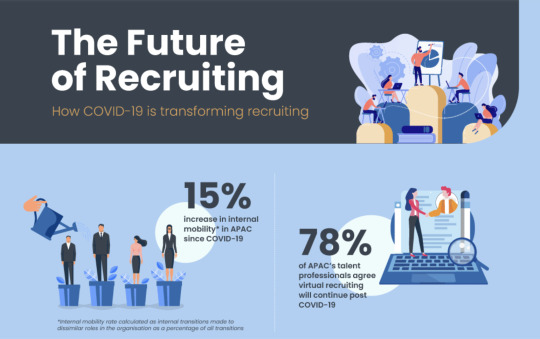#hirenest
Explore tagged Tumblr posts
Text
Emotionally Intelligent People
Are emotionally intelligent people better at their jobs? If you want to get hired, would you rather hire someone who is good at reading other people or someone who is good at themselves?
Emotional intelligence (EI) refers to the ability to perceive emotions in oneself and others and regulate them effectively. EI has become a hot topic in recent years because of its potential impact on our personal lives and careers.
Research shows that emotional intelligence plays a key role in determining job performance. In fact, some studies suggest that hiring managers prefer candidates with high levels of EI over those with lower scores. This means that hiring managers tend to look for employees who are able to read situations accurately and respond appropriately. Learn more: https://blog.hirenest.com/emotionally-intelligent-people-tend-to-be/

There are many different types of emotional intelligence tests available. The most common ones include:
• The Mayer–Salovey–Caruso Emotional Intelligence Test (MSCEIT), developed by Dr. Daniel J. Mayer, which measures four domains of emotional intelligence: self-awareness, social awareness, emotion management, and motivation;
• The Big Five Inventory (BFI) was created by psychologists Paul Costa Jr., Robert McCrae, and Richard P. John. It consists of five subscales measuring extraversion, agreeableness, conscientiousness, neuroticism, and openness.
In addition to being able to predict whether someone will develop schizophrenia, researchers believe that they may also be able to identify people who are at risk of developing it before symptoms appear. This would allow them to intervene earlier than currently possible.
What Is Emotional Intelligence?
The ability to understand our emotions and those around us is known as emotional intelligence (EI). It has three main components: self awareness; social skills; and motivation.
EI is one of the most important predictors of success at work. People who score highly in EI tend to be happier, healthier, better leaders, and perform better than people who don’t.
Emotional Intelligence is not just about being able to read someone else’s mind. It’s about understanding what makes them tick and using this knowledge to motivate them to do things they wouldn’t otherwise want to do.
Why to Hire Emotionally Intelligent People
The first step is to understand what emotional intelligence actually means. It's not just being nice to people; it's knowing how to read others, empathize with them, and communicate with them. Emotional intelligence helps us navigate our relationships better, which leads to greater happiness and success.
In fact, the most successful leaders tend to be those who are able to connect emotionally with their employees. They're able to see things from their perspective, so they know how to motivate and inspire them.
The best leaders don't just tell people what to do; they listen to understand what motivates them. They ask questions to find out what's important to their team members. And they help them develop strategies to achieve their goals.
Emotional Intelligence: The Most Overlooked Candidate Skill
“I don’t know what I would do without her,” says one client who has worked with me for years. She’s referring to her coach, not her therapist. Her relationship with her coach has changed her life. It’s helped her find purpose and direction after she lost her job and was struggling to figure out where to turn next. You can find out more in our article: https://blog.hirenest.com/emotionally-intelligent-people-tend-to-be/
Emotional intelligence (EQ) refers to our ability to understand ourselves and others, manage emotions, communicate clearly, resolve conflicts, and build relationships. EQ is like a muscle—the stronger it gets, the better we perform at work, school, home, and in all aspects of life.
In fact, emotional intelligence is so important that some researchers believe it should be taught in schools alongside reading, writing, math, science, history, and geography.
The Benefits of Emotional Intelligence. People who score high in emotional intelligence tend to do well in every area of life. They're more likely to succeed academically, earn higher salaries, enjoy greater health, and live longer.
High emotional intelligence helps us deal with stress, stay calm during difficult times, and focus on what's most important. It also makes us happier overall.
How to Improve Your Emotional Intelligence
The first step is to recognize what emotional intelligence means. It’s not just being able to read people’s emotions; it’s understanding why we feel the way we do and using this knowledge to improve our relationships.
There are many different ways to develop emotional intelligence, but one of the most effective is through mindfulness training. Mindfulness involves paying attention to the present moment without judgement. This helps us notice our thoughts and feelings, which gives us insight into our behaviour.
Mindfulness has been shown to help reduce stress levels, anxiety, depression, anger, fear, worry, and negative thinking. It improves self-awareness and empathy, helping us understand others better. It also increases our ability to focus, concentrate, and manage our impulses.
A study published in 2018 found that mindfulness meditation could significantly increase the size of the hippocampus — the part of the brain responsible for memory formation and consolidation. In addition, the researchers noted that the practice had positive effects on mood and cognitive function.
Conclusion
In one study, researchers found that emotionally intelligent people tend to be more successful in business than those with lower emotional intelligence. They also tend to make better hires. This may seem counterintuitive since we often think of emotional intelligence as being something that makes us less effective leaders. However, when it comes to hiring, emotional intelligence actually has a positive effect. It allows candidates to see past superficial differences between themselves and potential employers. Instead, they focus on what each person brings to the table.
The same goes for our relationships. Emotional intelligence helps us understand others and ourselves. It gives us insight into why someone might act a certain way. And it lets us know if we need to change our behavior to improve communication. If you want to know more about Emotionally Intelligent People Tend to Be Better Hires? 10 Behaviors, read this article: https://blog.hirenest.com/emotionally-intelligent-people-tend-to-be/
#hirenest blog#hirenest#human resources#soft skills#pre-employment tests#Emotionally Intelligent People#Emotional intelligence
2 notes
·
View notes
Text
Trainability
Hiring managers and recruiters often struggle to identify the best candidates because they don't have enough time or resources to conduct thorough background checks. This leads them to hire unqualified applicants who might turn out to be bad hires. Learn more: https://blog.hirenest.com/why-recruiters-should-look-trainability/

The average hiring manager spends only 2 hours per week screening resumes. That means they miss out on hundreds of qualified candidates every month. A study conducted by one big company found that nearly half (46%) of employers say their biggest challenge is finding qualified talent. In addition, over 40% of companies report having difficulty filling open positions due to lack of skills and experience. If you're looking for a job, it's important to keep your resume updated. Every few months, update your resume with new skills and experiences. It will help you stand out from the crowd and give you a competitive edge.
The ability to learn new skills quickly is one of the most important traits in any employee. And yet, we often overlook this trait when hiring people. We assume that everyone has the same level of trainability as us. This assumption is wrong. In fact, some people are more trainable than others.
What makes a person trainable?
“Trainability” refers to someone's ability to learn new skills quickly and easily. In fact, trainable people tend to be more successful than those with high IQs but low trainability. You can find out more in our article: https://blog.hirenest.com/why-recruiters-should-look-trainability/

The answer lies in the way we think about training. If you look at the history of sports, it was only after people started thinking of training as a process of adaptation that they began to see improvements in performance. This is why I believe that the best approach to training is not just to focus on what you want to improve but rather to understand where you currently stand and then work backwards from there. The most important thing I learned was that it's not just about what people say they want; it's about what they actually do. If someone says he wants something, but doesn't act like he really does, then we should assume he doesn't really want it. This is why I think it's so important to look at behavior change from the outside, rather than focusing only on what people tell us they're doing.
Trainability Addresses the Widening Skills Gap
The skills gap has become one of the most pressing issues facing our economy today. In fact, it’s so important that President Obama recently called it “the defining challenge of our time.” According to the Bureau of Labor Statistics, nearly half of all jobs will require some form of training by 2020. And yet, only about 20 percent of Americans say they feel prepared for those new roles.

So what does this mean? It means we must train people differently than we did before. It means we must teach them not just how to do things but why they should care about doing them. It means we must help them understand the importance of being able to perform at high levels consistently.
This is where the power of gamification comes into play. Gamification isn’t just another buzzword—it’s a proven way to motivate employees and increase engagement. Companies like Zappos, Disney, and Google have used gamification to great success. They know that if you want someone to complete something, give them a little incentive. If you want them to work harder, give them a bigger reward. If you want them excited about their job, give them a chance to compete against others.
Conclusion
A recent study found that hiring managers rate trainable candidates as more desirable than those with experience. This was true even when the candidate had no relevant work experience. In fact, recruiters rated trainable candidates as much more desirable than experienced ones. So why does this happen?

The answer lies in our brains. While we tend to think of ourselves as rational beings who weigh all information before making decisions, new research suggests otherwise. Our decision-making process is actually based on emotions rather than logic. Researchers at Cornell University conducted two experiments to test whether people would prefer to hire someone with little experience but lots of potential versus someone with years of experience but less potential. They asked job applicants to complete a personality questionnaire called the Big Five Inventory (BFI). Applicants were then given mock interviews where they answered interview questions. Afterward, they completed another BFI survey. Those who scored high on extraversion and conscientiousness were deemed “trainable.” Trainable candidates received higher scores from both the interviewer and applicant surveys. But what really stood out was that the results held regardless of the applicant’s level of experience. Even though the trainable candidates had fewer years of experience, they still received higher ratings from the interviewer and applicant surveys than did the experienced candidates. This study shows that even with less experience, trainable candidates were rated more highly by interviewers and applicants. It also showed that the difference between the two groups was consistent across all levels of experience. So, while some people may think that hiring managers prefer experienced candidates over those with less experience, this study suggests that they don't necessarily make such distinctions when evaluating candidates.

The study found that interviewers were able to identify trainable candidates at rates similar to those who scored well on the applicant survey. This suggests that hiring managers may not need to rely solely on applicant feedback to identify potential trainees. It turns out that the way we perceive others has a lot to do with how we feel about ourselves. For example, if we believe that we’re not smart enough to succeed, it will affect how we view others who seem smarter than us. If we don’t see ourselves as capable, we won’t try hard enough to achieve success. And if we don’t like ourselves, we won’ t want to help others improve either. If you want to know more about Trainability: Why Hiring Managers and Recruiters Find It in the Best Talent?, read this article: https://blog.hirenest.com/why-recruiters-should-look-trainability/
#hirenest#pre employment assessments#blog hirenest#recruiting#hirenestblog#bloghirenest#pre-employment assessments#hirenest blog#pre-employment screening tests#pre-employment screening assessments#pre employment screening tests#pre employment tests#Trainability#Hiring Managers#Hiring Managers and Recruiters#Recruiters#Hiring#career#jobs
0 notes
Text
Providing Constructive Criticism
How often should you provide constructive criticism? There are two types of feedback: positive and negative. Positive feedback helps us improve our performance, whereas negative feedback motivates us to change our behavior. The problem is, that sometimes we don’t realize when we’re providing negative feedback. This leads to resentment, frustration, and even anger. Learn more: https://blog.hirenest.com/providing-constructive-criticism-to-employees/

When giving feedback, focus on the positives. If you want to motivate someone, give them only positive feedback. In this case, I was trying to help him understand why he wasn't getting any responses from his audience. He had already tried to figure out what was wrong by himself, but it didn't work. So I pointed out the obvious mistake (he forgot to include the "?") and told him not to worry about it because people will forget things like that. It's just part of being human.
What are Examples of Constructive Criticism?
The first step in any writing project is to write down what you want to say. Then edit it so it makes sense. If you don’t know where to start, try brainstorming ideas. Once you have some ideas, narrow them down into a list of topics. You can find out more in our article: https://blog.hirenest.com/providing-constructive-criticism-to-employees/

How do I avoid being too critical? When giving feedback, focus on the positive aspects of someone's work rather than criticizing mistakes. Instead of saying "You're wrong," say something like "I think this could be improved by..."
How do I give constructive criticism? The best way to give constructive criticism is to ask yourself if you would benefit from the information. For example, if you notice that a colleague has a habit of leaving his desk at lunchtime without telling anyone, then you might consider asking him why he does this. It may not seem like a big deal but it could help him improve his productivity.
In order to achieve success, we must take responsibility for our actions. This means taking ownership of our decisions, instead of blaming others. It also means accepting accountability for our failures.
Why is Constructive Criticism in the Workplace Important?
It helps us improve our performance. If we don’t hear feedback from others, we may not know what we’re doing well or where we could improve. This means we might miss out on opportunities to grow and develop. I think it’s important to give honest feedback. But if someone criticises me too harshly, they risk making me feel defensive and resentful. That will lead to them losing respect for me, which will affect our working relationship.

Benefits of Constructive Criticism in the Workplace
The most important thing I learned from this experience was to never give up. If you want something badly enough, you will find a way to achieve it. A lot of people think they don't know anything about business management, but if you're willing to study, you'll quickly realize that you do know quite a bit. In order to succeed at work, you must first understand what motivates you. What makes you tick? Why do you wake up every morning? What keeps you going through all the stress and pressure of life? Once you figure out why you do what you do, then you can start working towards making those things better.
It's not just about the money. There are many reasons why someone would choose to become self employed. For some, it's because they enjoy being their own boss. Others may prefer to work independently so they can set their own hours. Some like the flexibility of having their own schedule. Whatever the case may be, becoming self employed means taking control of your future.

Providing Constructive Criticism to Employees
The first step in providing constructive criticism is to identify what needs improvement. This may seem like a simple task but it’s often difficult because people don’t want to hear negative feedback. They might feel they’ve done something wrong or that the person giving them the feedback doesn’t know anything about their work. If you do decide to provide constructive criticism, try not to focus too much on the negatives. Instead, focus on the positives. For example, if you notice that someone has made mistakes in the past, ask them how they plan to improve next time. Or, if you see that a particular area of weakness is causing problems for others, explain why this is important so that they understand the impact of their actions.
Provide Feedback to Your Team Members. Once you’ve identified areas where improvements could be made, give your team members specific examples of what you noticed. Don’t just say “you did a bad job”; instead, describe exactly what went wrong and offer suggestions for how they can fix it. Be sure to include any positive aspects of their performance.

Tips on How to Give Constructive Criticism
The first step is to identify what you like about the person. This will help you avoid criticizing something they don't care about. For example, if you're talking about their appearance, it's better to say "You look great today" than "Your face looks terrible." If you want to criticize them, focus on one thing at a time. It's easier to give constructive criticism if you keep things simple.
Next, think about why you feel this way. Is it because they did something wrong? Did they do something right but not enough? Was it just bad luck? Or maybe you dislike them because they remind you of someone else who was mean to you. Whatever the reason, try to understand where it comes from before deciding whether or not to share your thoughts. The first step in giving constructive criticism is to identify what needs improvement. This means being specific and clear about what it is you want to see changed. For example, if you notice that someone has trouble following through on assignments, say so directly rather than saying something like “I don’t think you did enough work this week.”
If you find yourself getting frustrated by a colleague’s lack of progress, try not to take things personally. Instead, focus on the task at hand. Ask yourself whether you could do better, then ask yourself why you might not be able to. It may help to write down your thoughts.

Conclusion
If you want your employees to improve, then constructive criticism is one of the best ways to go about doing so. This article provides some great tips on how to provide effective feedback to your team members. When providing feedback to your employees, make sure you are being as specific as possible. It's easy to give vague feedback, but when you're trying to help someone improve, you need to be more direct with what needs to change. Don't just say "you should work harder" or "I think you should try something new." Instead, tell them exactly what you mean by those statements. Be clear about what you expect from them and why.
Feedback is not always positive. Sometimes it may feel like you're criticizing your employee, which could lead to defensiveness or resentment. Try to avoid this situation by making sure you're giving honest feedback. While you don't want to hurt anyone's feelings, you do want to encourage growth and improvement. Make sure you're focusing on areas where they can grow rather than things that aren't working well. If you want to know more about Defining Recruitment Skills + 10 Top Skills to Have in 2022, read this article: https://blog.hirenest.com/providing-constructive-criticism-to-employees/
#hirenest#bloghirenest#hirenestblog#pre employment assessments#pre-employment screening tests#pre-employment assessments#hirenest blog#pre-employment screening assessments#blog hirenest#recruiting#pre employment tests#pre employment screening#pre employment screening tests#Constructive Criticism
0 notes
Text
Mobile Recruiting
How would you describe mobile recruiting? What does it entail? How can you get started? Mobile recruitment has become a major part of the job market today. The number of smartphone users continues to increase, and companies are looking for ways to reach out to potential employees through their smartphones. Learn more: https://blog.hirenest.com/mobile-recruiting-in-2022-and-beyond/

Mobile recruiting is a type of marketing where recruiters send messages or applications directly to prospective candidates via their phones. This method allows employers to target specific groups of individuals who might otherwise never hear from them.
What Is Mobile Recruiting?
The term “mobile recruiting” refers to using mobile devices (phones) to reach out to potential candidates for jobs. This method has become increasingly popular because it allows recruiters to find qualified job seekers at any time and place. It also helps them save money by not having to pay for office space and hiring additional staff. You can find out more in our article: https://blog.hirenest.com/mobile-recruiting-in-2022-and-beyond/

Why Use Mobile Recruitment? Mobile recruitment offers several advantages over traditional methods of finding employees. For example, it saves companies money by allowing them to access talent from anywhere at anytime. It also gives employers the opportunity to hire people who might otherwise be overlooked due to geographical limitations. In addition, mobile recruitment provides flexibility for both employer and employee. Employers can choose which location they want to work from, and employees can decide where they want to live.
Mobile recruiting is one of the most effective ways to find new hires. According to a recent survey conducted by CareerBuilder, 81% of respondents said that they would consider applying for a job through a mobile app if given the chance. The first step in creating a successful mobile recruiting strategy is understanding what kind of content will attract users. A few things to keep in mind include:
Mobile recruitment has become increasingly popular among employers because it allows them to reach potential candidates at any time and place. It’s especially useful for companies who want to hire people without having to pay for advertising space during normal business hours.
In addition to the obvious advantages of being able to access job seekers 24/7, mobile recruitment offers several unique challenges. For example, most jobs require applicants to submit resumes online. This means that recruiters must find ways to capture information from job seekers using apps and websites that don’t look like typical job boards.
What are the benefits of mobile recruiting?
Mobile recruitment has become increasingly popular because it allows recruiters to target potential candidates at any location and time they choose. It also provides flexibility for employers who want to hire people outside normal business hours.

The downside is that mobile recruitment requires a lot of effort from both parties. Recruiters must spend time creating a profile, uploading images, writing descriptions, and answering questions. Candidates must then search through those profiles and apply directly from their phones. As a result, many companies are now turning to automated systems like Applicant Tracking Systems (ATS) to streamline this process. ATS software matches job seekers with available positions based on criteria including skills, experience, education, and geography. This helps eliminate the manual work required by recruiters and increases efficiency.
There are two main types of ATS software: applicant tracking systems and resume management systems. Resume management systems allow users to upload resumes into a database where recruiters can find them. Applicant tracking systems do not require resumes but instead look for keywords associated with each job posting. Both types of software help reduce the amount of time spent searching for qualified applicants. In addition to being able to track applications, ATS software can provide valuable insights into candidate performance. For example, some programs will automatically score every application using a variety of metrics, such as response rate, number of applications per day, and length of time between applications. These scores can be used to identify underperformers and determine which jobs might benefit most from additional outreach.

Tips and strategies for effective mobile recruiting
Mobile recruitment has become increasingly popular due to its convenience and cost effectiveness. It is now used by many companies including Google, Facebook, Uber, and Airbnb. The downside is that it is difficult to track who is responding to your adverts and whether they are actually interested in your job role.
To help overcome this problem, we recommend using a combination of different methods to recruit people. For example, if you want to target younger audiences then you could advertise on Instagram or Snapchat. If you want to reach older audiences then you might consider advertising on LinkedIn or Twitter.
In addition to targeting specific demographics, you should also think about where your potential recruits will be located. This means understanding what type of location they live in (e.g., city centre vs suburb) and which areas within those locations are most likely to attract them (e.g., university campuses).
Conclusion
The mobile recruiting industry has exploded over the past few years with new apps being created every day. There are now more than 1 million job seekers using mobile recruiting apps each month. These apps make finding jobs easier by allowing users to search for jobs based on location, company size, salary range, etc. They also allow recruiters to find candidates quickly and easily. Mobile recruiting apps are great tools for both employers and employees looking for work. Employers benefit from having access to a large pool of qualified applicants at any given moment. Candidates benefit because they don’t have to spend hours searching for a job online. Instead, they can apply directly through the app and receive notifications immediately if they were selected for an interview.
If you’ve ever tried to hire someone, you know it takes weeks or months before you finally land that perfect candidate. It’s not uncommon for companies to spend thousands of dollars on advertising only to see little success. That’s why many people turn to hiring agencies who charge hundreds or even thousands of dollars per placement. But what happens after the initial contact? How do you follow up with them once they join your team? What if they quit? Do you still owe them money?
In addition to saving time and money, mobile recruiting apps help businesses save on recruitment costs. Companies can set up automated processes to send out applications to potential hires without needing to pay a recruiter. This saves them money and allows them to focus on growing their business instead of spending time managing their staffing needs. If you want to know more about Mobile Recruiting (Mobile Recruitment) in 2022 to Surprise You, read this article: https://blog.hirenest.com/mobile-recruiting-in-2022-and-beyond/

#hirenest blog#hirenest#bloghirenest#recruiting#hirenestblog#pre-employment assessments#pre-employment screening tests#pre-employment screening assessments#blog hirenest#pre employment assessments#effective mobile recruiting#mobile recruiting#Mobile Recruitment
0 notes
Text
Improve Candidate Experience
How do you improve candidate experience? What are some ways to increase the chances of candidates applying to jobs at your company? Candidate experience refers to the overall impression candidates get from their interactions with companies. Learn more: https://blog.hirenest.com/how-to-improve-candidate-experience-in-2022-to-attract-the-best-talent/

This includes things such as job postings, interviews, onboarding processes, and other touchpoints throughout the hiring cycle. Companies should focus on improving the candidate experience across multiple channels. For example, they should consider creating a better job posting or interview questions. They also should ensure that new hires receive training and support during the onboarding process.
The most important thing you can do to improve the candidate experience is to listen to what candidates want. Candidates will tell you if something isn’t working well, so it’s critical to hear them out. If you don’t, you may miss opportunities to fix problems before they become big issues.
A great example of this is the “candidate experience” at one company I worked with. They had a lot of trouble getting people to apply online because the process was too complicated. So they decided to simplify the application process by making it all happen through email. This made it easier for everyone to complete the process, but it didn’t solve any real problem. In fact, it created new ones. People were complaining that they couldn’t find information they needed, and some applicants were having difficulty completing forms correctly.
The solution? Make sure every step in the application process is clear and easy to understand. If someone has a question, provide them with the answer right away. And if you don’t know the answer, ask! You can find out more in our article: https://blog.hirenest.com/how-to-improve-candidate-experience-in-2022-to-attract-the-best-talent/

Why is the candidate experience important?
The candidate experience refers to the overall impression candidates form after interacting with a company. It includes things like whether they feel welcome, if they had a positive first interaction with someone from the organization, and what kind of information they received during this initial contact.
A recent study found that companies who ranked high in customer satisfaction were able to increase revenue by $1.7 million per year. Companies that scored poorly on customer service metrics saw a decrease in revenue of $2.5 million annually.
In order to improve the candidate experience, it's critical to understand why people leave jobs. According to one survey, 60% of employees say they would stay at their current job longer if they felt valued and appreciated. Another 20% said they'd stick around if they knew their work was making a meaningful contribution. And nearly half (46%) said they wouldn't want to continue working if they weren't being challenged.
Positive vs negative candidate experience
Candidate Experience (CE) refers to the overall customer experience during the recruitment process. It includes everything from the way candidates are treated by the company recruiter, to the quality of the interview environment, to the level of communication between the hiring manager and the applicant throughout the entire process.
The most important thing recruiters should do is to ensure they understand what CE means before they start recruiting. This will help them focus on improving the candidate experience rather than just focusing on finding new talent.
What makes a great candidate experience? Candidates want to feel valued and appreciated. They want to know that their opinions matter and that they are being heard. They want to see that the company cares about them and wants to hire them. They want to know they are going to be given opportunities to grow within the organization. They want to know if they fit into the culture of the team and the company. And they want to know that they will receive fair compensation based on their skills and experience.
The best way to improve your candidate experience is to communicate clearly and consistently with your applicants. If you don't, it's easy for them to become confused and frustrated. Make sure all communications are clear and concise. Provide feedback regularly so that candidates know where they stand at any point in the process.
In order to achieve this, we must first understand what exactly constitutes a positive candidate experience. There are many factors that contribute to a positive candidate experience. These include:
* A strong brand identity, which helps build trust and credibility among customers.
* An effective website design, which allows users to find information easily.
* Clear messaging, which ensures that visitors understand what the business does and why they should care.
* Customer service, which provides excellent support to existing clients and potential new ones.
Candidate Experience (CX) refers to the overall positive or negative impression candidates form about your company when interacting with your brand online. It includes everything from the way your website looks and feels to whether your sales team responds quickly to inquiries. CX is one of the most important factors in determining candidate engagement and success. A strong CX allows you to attract more qualified candidates and convert them into customers. Conversely, a poor CX can cause candidates to lose interest and ultimately reject your offer.
Conclusion
In today's competitive job market, employers are looking for candidates with skills that go beyond just being qualified. They want people who are willing to learn new technologies, solve problems and work well as part of a team. To attract top talent, organizations must create a candidate experience that reflects what they value most in employees. This includes creating a culture where employees feel valued and appreciated. It also involves providing opportunities for growth and development, offering flexible schedules and working conditions, and giving employees time off when needed.
The best way to do this is by using a recruitment agency. These companies will find you jobs based on your skills and experience, then place you at one of their clients. If you're self-employed, you could advertise yourself as a freelancer online, or set up your own website and list your services there. If you want to know more about How to Improve Candidate Experience in 2022 to Attract the Best Talent, read this article: https://blog.hirenest.com/how-to-improve-candidate-experience-in-2022-to-attract-the-best-talent/

#blog hirenest#hirenestblog#recruiting#pre-employment assessments#pre-employment screening tests#hirenest blog#pre-employment screening assessments#pre employment assessments#hirenest#bloghirenest#candidate experience
0 notes
Text
Improve Employee Retention
How often do employees leave their jobs because they don’t enjoy working at the company anymore? If you want to improve employee retention, you should focus on improving the workplace culture. Learn more: https://blog.hirenest.com/idea-sharing-tips-that-will-improve-employee-retention/

The average tenure of an employee has decreased from 11 years in 2000 to only 7 years today. This means that companies now have to invest heavily into retaining their current workforce.
Employee turnover costs employers billions of dollars each year. In addition to the financial burden, these losses also affect productivity and morale. Companies that are able to retain their staff tend to outperform those who struggle to attract new talent.
It’s not just employees that leave; it’s also customers. According to a study by Harvard Business Review, customer retention rates drop by 10% after every 12 months. If you want to keep your customers happy, then you should do everything you can to ensure they feel valued and appreciated.
What is employee retention?
Employee retention refers to the percentage of employees who stay at one company for a certain period of time. It is calculated by dividing the number of employees who stayed at the same organization for at least six months by the total number of employees hired during this period. You can find out more in our article: https://blog.hirenest.com/idea-sharing-tips-that-will-improve-employee-retention/

The most important factor affecting employee retention is job satisfaction. Employees who feel satisfied with their jobs tend to remain longer than those who do not. Other factors include pay, promotion opportunities, work environment, and career growth.
In addition to job satisfaction, another key factor influencing employee retention is performance. If employees perform well, they will receive recognition from management and colleagues. This may lead them to develop positive feelings toward the company and its products/services. On the contrary, if employees do not perform well, they will be demotivated and eventually leave the organization.
Employee engagement is defined as “the degree to which employees enjoy working for their employer.” Engaged workers are motivated to achieve organizational goals and are committed to the success of the organization. They are willing to invest extra effort into achieving organizational objectives.
A study published in the Journal of Occupational Health Psychology found that people who were engaged in their jobs had higher levels of self-esteem and lower levels of depression than those who were less engaged. Another study showed that engaged employees reported better health outcomes than disengaged employees.
How to Improve Employee Retention
The first step is to identify the problem. If employees aren’t happy at work, they won’t stay long term. So figure out why people leave and what could be done to improve retention.
A study published in the Journal of Occupational Health Psychology found that workers who felt like their company cared about them were less likely to quit than those who didn’t feel this way. This suggests that companies should invest in creating a positive culture where everyone feels valued.
A Few Strategies to Improve Employee Retention
The first step is to understand what makes employees tick. What motivates them? How do they like to work? Do they prefer working from home? Are they looking for flexibility? Is it important to them to feel part of something bigger than just their job? These answers will help you identify which strategies might appeal most to your team members.
If you want to motivate people, then you should start by understanding why they don’t already feel motivated. This means asking yourself some tough questions. Why aren’t they doing this task? Why isn’t anyone else doing it? Why does everyone else seem so happy and successful at this task? Once you know the answer to these questions, you can begin to think about ways to change things around. In fact, one study found that employees who were given access to a gym during their lunch break were twice as likely to stay with their employer than those without access. Another study showed that having a kitchenette where employees could prepare meals was associated with higher employee retention rates. And yet another study found that offering flexible hours was linked to lower turnover rates.
It’s not enough to simply offer perks; you must also provide opportunities for growth. For example, if you’re trying to attract top talent, consider offering training programs, mentoring programs, or internships. Or if you want to retain current staff, give them a chance to advance within the company.
Make sure your employees feel valued. This includes giving them opportunities to learn new skills and grow professionally. It also means providing them with flexible work schedules and benefits such as health care coverage.
If you’re looking to hire someone who has experience working at a startup, it might be worth considering hiring from outside your organization. Startups often look for people with entrepreneurial spirit and a willingness to take risks. These traits aren’t always easy to find among existing employees.
Conclusion
A recent study by LinkedIn found that employees with access to company-wide data were more likely to stay longer than those who did not. This has led some organizations to provide all employees with free access to corporate data such as sales figures, customer service calls, product usage statistics, etc. These tools help employees make smarter decisions about where to spend their time and what projects to work on. In addition, providing access to internal data empowers employees to identify opportunities that may otherwise go unnoticed.
The most common way to do this is through social media. Companies like Facebook and Twitter allow users to share information and connect with others online. They also offer analytics software which allows companies to track user activity and understand what content is working best. If you want to know more about Idea Sharing Tips That Will Improve Employee Retention, read this article: https://blog.hirenest.com/idea-sharing-tips-that-will-improve-employee-retention/

#hirenest blog#hirenest#recruiting#blog hirenest#pre-employment assessments#pre-employment screening tests#pre-employment screening assessments#pre employment assessments#hirenestblog#bloghirenest#Employee Retention#Improve Employee Retention
0 notes
Text
Remote Hiring Process
How would you rate the effectiveness of remote hiring processes? Hiring managers often struggle to find qualified candidates who meet their expectations. They might even resort to using recruitment agencies or outsourcing their jobs to third parties. This leads them to hire unqualified employees, which affects both their productivity and morale. Learn more: https://blog.hirenest.com/remote-hiring-process/

However, there are ways to improve the efficiency of the hiring process. If you want to attract top talent, you should consider implementing some of these strategies.
The first step is to understand what makes people tick. What motivates them? Why do they work so hard? And why do they quit? These answers will help you identify the best way to communicate with potential hires. For example, if you know that someone likes working alone, then it may not be appropriate to ask him/her to join a team right away. On the other hand, if you know that he/she enjoys being part of a group, then you could start by asking him/her to join one project before moving onto another.
Remote work has become increasingly popular among companies around the world. It allows workers to live where they choose, without having to commute long distances every day. In fact, many companies now offer flexible hours, allowing employees to work from home at least half the week. This means that they don’t have to sacrifice their quality of life just because they happen to be employed somewhere else. You can find out more in our article: https://blog.hirenest.com/remote-hiring-process/

How the Remote Hiring Process Works
The process starts by filling out our online form. This will take around 10 minutes and we'll then review it before moving onto the next step. After this initial stage, we'll contact you within 24 hours to schedule a phone call with one of our recruiters. During this conversation, we'll discuss what you're looking for in a role, whether you'd like to work remotely, and if so, where you live. Once we've got all the information from you, we'll start sending you jobs based on your preferences. If you want to work remotely, we'll send you job postings tailored to your location. You can choose which ones you apply to, and once you accept a role, we'll set you up with everything you need to hit the ground running. As well as being able to hire remote workers, we offer flexible working hours and pay rates that reflect the cost of living in different regions. Our average hourly rate is $25/hour, but we pay significantly less in some areas than others.
Remote Interviews
The first step in any interview process should be to ask yourself what you want out of this job. What do you hope to gain from it? How will you benefit if you land this role? This way, you can prepare for the interview by thinking through your answers before you meet the hiring manager.
If you don't know what you're looking for, then you'll never find it. It's important to think about why you're applying for a particular role. Do you want to work at a specific company? Are you hoping to move into a new industry? Or perhaps you just want to try something different. Whatever your motivation, take some time to reflect on what you really wanIn addition to being able to assess personality traits, remote interviews also help me build rapport with applicants. By talking to them online, we can establish common ground and form a connection. That makes it easier for us to discuss things like salary expectations, career progression, and future plans.t out of life. Once you've figured out what you want, you can start searching for opportunities that align with those goals.

A lot of people assume that remote interviews are only suitable for candidates who live far away from the office. But I actually prefer them because they give me a chance to see whether someone has the right personality for working remotely. They also allow me to talk to potential hires without having to travel all the way to their home city.
How to develop a stronger remote-first hiring process
The best way to hire people remotely is to start by having them come into the office. This allows you to see who they really are and what kind of culture fits well with yours. It also gives you the opportunity to interview them face-to-face.
If you don't want to do this yourself, consider using one of the many services out there that will help you find candidates. These include:
LinkedIn Talent Solutions - LinkedIn's talent solutions team has created a platform called TalentStream that helps companies build better teams through recruiting automation.
A recent study from Harvard Business Review found that employees who work remotely tend to be happier than those who work in offices. They're less likely to feel stressed at work and more likely to enjoy their jobs. Remote workers also report higher levels of job satisfaction and engagement, according to the survey.
In addition to being a great place to live, it’s also a great place to work. According to the World Economic Forum, Switzerland ranks first among all countries for quality of life, followed closely by Australia, Canada, Sweden, New Zealand, Norway, Finland, Denmark, Iceland, Netherlands, Germany, Austria, Ireland, Luxembourg, Belgium, Spain, Italy, France, Portugal, Japan, Singapore, United Kingdom, and finally the U.S.
Conclusion
The remote hiring process has become more popular as businesses try to find ways to reduce costs while still maintaining quality talent. It allows candidates to apply online and interview via video chat with potential employers. This method eliminates the need for travel expenses and time away from work. Candidates also benefit by being able to conduct interviews when it works best for them.
Remote working isn’t just for millennials anymore. In fact, nearly half (46%) of all U.S. employees now telecommute at least some of the time, according to Gallup. That number is expected to rise to 54% by 2020.
As a result, many companies are offering flexible hours and remote work options to attract top talent. For example, Google offers unlimited vacation days and pays its workers an average salary of $150k per year. Amazon lets employees work remotely five days a week and offers generous paid leave policies. And Facebook recently announced plans to offer four weeks of fully paid parental leave. If you want to know more about All About the Remote Hiring Process, read this article: https://blog.hirenest.com/remote-hiring-process/
#hirenestblog#recruiting#blog hirenest#hirenest blog#pre-employment assessments#pre employment assessments#pre-employment screening tests#pre-employment screening assessments#hirenest#bloghirenest#top talent#Remote working#remote work#Remote Interviews#Remote Hiring Process#Hiring Process#Remote Hiring
0 notes
Text
Recruiting Passive Candidates
How do you get passive candidates to apply for jobs? You've probably heard the term 'passive candidate' before. This refers to someone who applies for a job without actively searching for a new position. They might even be looking at other companies or industries. Learn more: https://blog.hirenest.com/recruiting-passive-candidates-how-to-do-it/

Passive candidates are often overlooked because they don't seem interested in applying for a job. In reality, these candidates are simply waiting for the perfect opportunity to come along. If you want to recruit them, you'll need to create a compelling offer that makes them want to join your team.
The best way to attract passive candidates is by creating a strong brand identity. Your company's mission statement should clearly define what it does and why people should care. It should also include values that align with the culture of your organization. Finally, you should communicate this message through all forms of media (e.g., website, social media pages, etc.)
If you're not sure which option will give you better results, consider outsourcing first. Outsourcing allows you to focus on growing your business instead of managing employees. Plus, you won't have to worry about finding qualified talent. An experienced freelance marketer can help you find the right person for the job. You can find out more in our article: https://blog.hirenest.com/recruiting-passive-candidates-how-to-do-it/

A lot of people think that hiring a virtual assistant is just like having a personal assistant. But there are some key differences between the two roles. For example, a virtual assistant may be able to handle certain tasks that require specialized skills, but they aren't always able to provide the same level of service as a personal assistant.
What is a passive candidate?
A passive candidate is someone who has already made the decision to retire. They may not yet know exactly what they want to do after retirement, but they have decided it will happen at some point in the future.
Passive candidates often feel like they don't have enough money saved to live comfortably during retirement. But if you're saving aggressively, you should be able to build a sizable nest egg by the time you reach age 65. And many people find that they enjoy working part-time once they've retired.
How to find passive candidates
The best way to find passive candidates is by using LinkedIn. It has become one of the most powerful recruitment tools available today. Companies that want to hire people will often post jobs on LinkedIn first. Candidates then apply directly through the company’s website.

In order to find passive candidates, I recommend creating a profile on LinkedIn. This allows you to list your experience, skills, education, and any certifications you may have. If you do not already have a LinkedIn profile, it is free to set up.
Why are passive candidates the best candidates?
The most common reasons I see people fail at becoming passive candidates are lack of self-awareness, poor communication skills, and fear of rejection.
If you want to become a passive candidate, it’s important to understand what makes you tick. What motivates you? How do you feel about yourself? Do you like who you are? Are you confident in your abilities? These are all things we should know before we start looking for opportunities.
Once you know what drives you, you can begin to communicate this to others. This will help them better understand why they should hire you. It will also give you insight into whether or not they would be a good fit for you.

As a passive candidate, you don’t ask for anything from the company. You simply show up every day and do your job well. Your performance speaks volumes. There are many ways to find out if someone is a passive candidate. One way is by asking them directly. Another is through observation. For example, if you notice that someone always arrives late to work, then you might assume that he/she isn’t reliable. Or if you observe someone being rude to customers, then you may conclude that they aren’t pleasant. Passive candidates are often overlooked because companies think they won't perform well. They're wrong! In addition to the above, there are some other factors that make passive candidates stand out. First, they tend to be highly motivated. They love what they do and are passionate about it. Second, they are usually very organized. Third, they are great communicators. And finally, they are extremely loyal.
Why do passive candidates outperform active ones?
Active candidates tend to focus on what they want from the company rather than what it wants from them. They may ask too many questions, which makes interviewers feel like they don’t know enough about the role to fill it.
Passive candidates take a different approach. They focus on what the company needs from them, not what they want from the job. This means they’re less likely to ask lots of questions during interviews. Instead, they listen carefully to what the interviewer says and respond appropriately.
The best way to prepare for an interview is to practice answering common interview questions. There are plenty of resources online where you can find sample answers to help you along.
Conclusion
If your company has a job board, then you probably already know about passive candidates. These are people who apply to jobs online but never follow up with any action. They may even forget about applying altogether. This makes them great candidates for hiring managers to reach out to. However, most job boards don't offer much more than a simple email address to contact them. And when they do, they often require a lot of work to make sure the candidate gets the message. A good recruiter can help you find passive candidates by using social media sites such as LinkedIn. By following potential candidates' networks, you can find out where they go, what they're interested in, and whether they've applied anywhere else. Once you identify a passive candidate, you'll want to connect with him or her first via email. Then, ask questions about his or her career goals and interests. Finally, ask if he or she has ever worked for a company similar to yours. If so, you might be able to hire him or her right away! If you want to know more about 14 Effective Tips for Engaging and Recruiting Passive Candidates, read this article: https://blog.hirenest.com/recruiting-passive-candidates-how-to-do-it/

#Recruiting Passive Candidates#Passive Candidates#Recruiting#pre employment tests#pre employment assessments#recruiting#blog hirenest#hirenest blog#hirenestblog#pre-employment screening tests#pre-employment screening assessments#pre-employment assessments#pre employment screening#bloghirenest#hirenest
0 notes
Text
Adverse Impact
What does adverse impact mean? And how can I minimize the negative impacts of my decisions? The term 'adverse impact' refers to the unintended consequences of a decision or action. Learn more: https://blog.hirenest.com/what-is-adverse-impact-how-to-minimize-adverse-impact-2022/

For example, if you hire someone who has a criminal record, then they might steal from you. Or if you fire someone without giving them notice, they might sue you. These types of situations are called adverse impact because they have a negative effect on the organization. Adverse impact happens when you take actions that negatively affect other employees, customers, suppliers, partners, or even society at large.
If you want to reduce the likelihood of these negative outcomes, you should consider the following three steps: (1) identify potential problems before taking action, (2) evaluate the risks associated with each option, and (3) choose the least risky course of action.
How can you reduce adverse impact?
The first step is to understand what makes people tick. This means understanding personality traits like conscientiousness, agreeableness, neuroticism, openness to experience, extraversion, and emotional stability. These traits influence everything from how we interact socially to our ability to focus at work. You can find out more in our article: https://blog.hirenest.com/what-is-adverse-impact-how-to-minimize-adverse-impact-2022/

Once you know this information, it's important to consider how each trait affects job performance. For example, if someone has high levels of conscientiousness, they're likely to be detail oriented and organized. They may also be reliable, punctual, and hardworking. But they might not be able to handle pressure well, so they could struggle in sales roles where deadlines are tight. On the other hand, someone who scores highly on agreeableness will tend to be friendly, empathetic, and easygoing. That person would do well in customer service positions but might find working under pressure challenging.
In addition to knowing yourself, you should also take into consideration the company culture and its values. If you don't fit in, it's unlikely you'll succeed. It's also important to remember that the best employees aren't necessarily the most talented ones; instead, they're those who are willing to adapt to new situations and embrace change.
What is an adverse impact example?
Adverse impact examples include things like discrimination, harassment, bullying, and physical violence. These experiences may happen at work, school, home, online, or anywhere else where people interact. They can affect anyone regardless of age, gender, race, ethnicity, religion, sexual orientation, disability, socioeconomic status, or any other characteristic.

The term “adverse impact” is used by the Equal Employment Opportunity Commission (EEOC) to describe situations where someone has experienced something negative because of his or her protected characteristics. For example, if a person is fired from a job because he or she is black, this would be considered an adverse impact.
Calculate Adverse Impact Ratios
The most common adverse impact ratio is the “pay gap.” This refers to the pay differential between men and women doing similar work. It’s calculated by dividing the average salary of male employees by the average salary of female employees. For example, if the average salary of all male employees is $100,000 per year and the average salary of all female employees is $80,000 per year, then the pay gap would be 20%. A more sophisticated approach to calculating the pay gap is called the “adverse impact ratio.” This method takes into account factors such as education level, occupation, industry, experience, job tenure, and location. Using this approach, the pay gap drops to 7%.
Pay Gap vs. Adverse Impact Ratio. The pay gap between men and women has narrowed significantly since the 1970s, but it still exists today. Women earn less than men in every occupation except one — teachers. In fact, they earn only 77 cents for each dollar earned by men. This gender wage gap is not new; it has existed throughout history. It was first documented in 1543 by German mathematician Christine de Pizan in her book “The Book of the Body Politic.” She wrote that women were paid half what men were paid for doing the same work.

Conclusion
When we talk about adverse impact, we mean any negative effect your business may experience as a result of implementing a new technology. This includes anything from lost revenue to increased costs. It also includes any legal issues that might arise. Adverse impact is something every company should consider when making decisions about adopting new technologies. If you don't think about it now, you'll regret it later. The first step in minimizing adverse impact is understanding what it means. A lot of people assume that if they implement a new technology, then they will suffer some sort of financial penalty. That's not necessarily true. For example, many companies already offer free Wi-Fi at work. They just charge employees for using it. So, by offering free Wi-Fi, they're actually saving money. But this doesn't mean that they won't lose customers because of it. In fact, most businesses find that providing free Wi-Fi makes them more attractive to potential clients.
The second step in minimizing adverse impact involves asking yourself whether the technology really needs to be implemented right away. There are times when waiting a few months before rolling out a new technology could save you a lot of headaches down the road. For example, if you know that you want to roll out a new product but aren't sure which one yet, you can wait to see how well it does before deciding to invest in manufacturing it. Or, if you've decided to launch a new service, you can hold off on signing up customers until you're confident that you can handle all of the demand.
Finally, you need to ask yourself whether the technology you're considering has any downsides. Some technologies come with risks attached. For example, if your organization uses social media sites like Facebook or Twitter, you need to understand who else is using those platforms so that you can avoid posting sensitive information. And, if you decide to start accepting credit cards online, you need to ensure that your website isn't vulnerable to hackers. If you want to know more about What Is Adverse Impact? How to Minimize Adverse Impact 2022, read this article: https://blog.hirenest.com/what-is-adverse-impact-how-to-minimize-adverse-impact-2022/

#hirenest#hirenestblog#bloghirenest#adverse impact#emotional stability#blog hirenest#pre-employment assessments#hirenest blog#pre-employment screening tests#recruiting#pre employment assessments#pre-employment screening assessments#pre employment screening
0 notes
Text
Improve Legal Defensibility
How does legal defensibility affect your business? What should you consider when choosing a lawyer? Legal defensibility refers to the ability of a company or individual to defend themselves against lawsuits. This means having enough resources to pay lawyers and other professionals who can fight back against claims from plaintiffs. Learn more: https://blog.hirenest.com/improve-legal-defensibility/

When selecting a law firm, look at their experience and reputation. Also, ask them about their fees and payment terms. If they don't offer contingency fee arrangements, then you'll want to choose another attorney.
The most important thing to remember about legal defense is that it's not cheap. It costs money to hire attorneys, experts, and consultants. And if you're sued, you may face significant financial penalties. So before hiring a lawyer, think carefully about whether you can afford to lose all or part of your investment.
In addition to being able to pay for legal services, you must also be able to pay for any potential settlements or judgments. If you cannot do so, you will likely end up losing everything.
A lot of people struggle with this question because they believe that the only way to succeed is by working hard. But what they fail to realize is that success comes from many different factors. Some of those factors include luck, timing, and opportunity. You can find out more in our article: https://blog.hirenest.com/improve-legal-defensibility/

What is Legal Defensibility?
The legal defensibility of the hiring process depends on many factors including the nature of the claim, the type of employment contract, the employer’s size and financial condition, and whether the employee has a union contract.
In general, employers may not discriminate against employees based on race, sex, religion, national origin, age, disability, genetic information, sexual orientation, gender identity, or veteran status. Employers cannot require applicants to take a drug test or provide proof of citizenship or immigration status. They must pay wages owed to employees who work overtime. Employers cannot retaliate against workers who file complaints or participate in investigations by government agencies. If you do decide to sue, it will likely cost you thousands of dollars in attorney fees unless you win. It’s important to note that if you lose, you could still end up paying damages to the defendant.
The first thing I do when hiring someone new is ask them what they think about the law. If they don't know anything about it, then we talk about it. It's important to understand the laws so you're not violating any rights of the employee.
What if you hire someone who has never worked before? This is a common question from people looking into starting their own business. There are some things you should consider before hiring someone who hasn't had experience working for anyone else.

Legal Guidelines for Pre-Employment Tests
The ADA prohibits employers from requiring medical examinations without reasonable cause. Employers may require pre-employment physical exams if they provide some legitimate business purpose (e.g., screening out applicants who cannot perform essential job functions). If an employer requires a medical exam before hiring, it must give the applicant notice of this requirement at least 30 days prior to the start date of employment.
The EEOC has issued guidelines regarding pre-employment testing. These guidelines state that “an individual with a disability does not lose his or her right to work simply by virtue of being disabled.” However, the guidelines also say that employers should take into account whether the employee poses a direct threat to himself/herself or others. An example of such a test might include asking questions about mental illness or substance abuse. In addition, the guidelines note that tests designed to measure cognitive ability may discriminate against individuals with disabilities.
The ADA provides protection for employees with disabilities who need accommodations to perform their jobs. This includes providing assistive devices, modifying policies and procedures, and reassigning duties.
Worst Mistakes of the Hiring Process
The hiring process should take place at least two weeks before the start date of the new employee. This gives both parties enough time to prepare for the interview and to iron out any issues that may arise during the interview process.
The best way to find out if someone is right for the job is to ask them directly what they think they will do well and what they would like to improve upon. If you don't know where to look, try asking friends who work in similar positions. They might not tell you everything but it's better than nothing.

Conclusion
A recent study by the American Bar Association found that more than half of all employers surveyed reported using social media as part of their hiring process. This was up from just over one-third in 2014. And nearly three out of four said they had hired someone based solely on what they saw online.
The survey also revealed that most companies were not doing enough to protect applicants against discrimination. Only 36 percent of employers said they provided training on equal employment opportunity laws, and only 27 percent said they monitored applicant activity on social networks.
In today's economy, hiring managers face more challenges than ever when trying to find qualified candidates. This has led to increased scrutiny of the hiring process by potential employees as well as third-party organizations such as lawyers and HR consultants. While most employers try to keep their processes confidential, some may feel compelled to make them public in order to prove their legitimacy. However, doing so creates a risk of legal liability. If your company does release its hiring practices publicly, it should consider using a third party to review and validate those documents. A lawyer with experience in employment law can help ensure that your policies comply with state and federal laws. If you want to know more about How to Improve Legal Defensibility of Hiring Processes: 5 Effective Ways, read this article: https://blog.hirenest.com/improve-legal-defensibility/

#hirenest#bloghirenest#Legal Defensibility#Improve Legal Defensibility#HireNest#hirenest blog#blog hirenest#pre-employment assessments#pre employment assessments#pre-employment screening tests#pre-employment screening assessments#recruiting#hirenestblog#Hiring Processes
0 notes
Text
Candidate Net Promoter Score
What is NPS? How does it work? What should I look out for? NPS (Net Promoter Score) is a metric used to measure customer loyalty. The idea behind it is simple: customers who are very satisfied with your company are likely to recommend you to their friends or colleagues. Learn more: https://blog.hirenest.com/candidate-net-promoter-score/

On the other hand, those who are dissatisfied with your service are unlikely to do so. This means that you can identify potential problems before they become big issues. You can calculate your NPS score using a questionnaire. Once you get your scores, you can analyze them to see where you stand compared to your competitors.
What is a good NPS score for recruitment?
The best way to find out what will work best for your organization is to test different strategies. For example, if you want to see whether emailing people who haven’t responded to previous emails works better than sending them a text message, you could do a small A/B test. If it doesn’t work well, then you know not to spend money on this strategy.
How do you calculate Net Promoter Score?
The NPS scale measures customer loyalty by asking customers if they would recommend a product or service to friends and family. It then calculates this percentage based on those who said “yes” and compares it against those who said “no”. A score above 70% indicates a positive brand experience.
This is calculated using the following formula:
NPS (Yes + Very likely) – (No + Not sure).
You can find out more in our article: https://blog.hirenest.com/candidate-net-promoter-score/

How to Determine NPS or Candidate Experience
The first step is to determine if the candidate experience is positive or negative. This means asking yourself whether the candidate was treated well by the company or not. If they were treated poorly, then it may be worth looking at why this happened. Was it because of something the candidate did? Or was it due to some sort of systemic problem within the organization?
There are two main types of candidates: those who want to work for you now (NPS) and those who will become customers later on (CX). It's important to understand which type of candidate you're dealing with so you know what actions to take next.

Research Regarding the Net Promoter Score
The net promoter score (NPS) is a simple way to measure customer loyalty. It’s calculated by subtracting negative responses from positive ones. A score above 0 indicates that customers who responded positively were more likely to recommend your company than those who didn’t respond at all. NPS scores range between -100 and 100. Companies with a score below 50 typically don’t enjoy high levels of customer loyalty. Those with scores around 60 tend to have loyal customers but could improve their scores through better marketing. Companies with scores above 80 typically have extremely loyal customers.
How to Calculate Your Own Net Promoter Score
To calculate your own NPS, simply take the number of people who gave you a 5 rating minus the number of people who rated you a 1 or 2. Then divide this figure by the total number of respondents. For example, if you received 20 ratings and 10 of them were 5s, then your NPS would be 40%. The most important thing to remember when calculating your own NPS score is that it only measures whether customers like you or not. It doesn't measure whether they will recommend you to others. If you're looking to improve your overall customer experience, you should consider using a third party tool to help you identify what's going wrong and how to fix it. There are many tools available online to help you calculate your own NPS. One of the best is called Net Promoter Score (NPS). This free tool allows you to easily calculate your company's NPS score. Simply enter your email address and click "Calculate."
What Is Net Promoter Score
The NPS was developed by Fred Reichheld at Bain & Company in 2003. It measures customer loyalty based on the degree to which customers recommend a company’s products or services to others. In short, it asks people whether they would recommend a product or service to friends and family.
How Does Candidate Net Promoter Score Work? The NPS works because most companies don’t know what motivates their customers. They assume that if they do things right, customers will love them. But this isn’t true. Customers aren’t loyal to brands; they’re loyal to individual employees who work hard to serve them well. If you want to understand why someone loves your brand, ask him or her directly. A study published in 2010 found that the average net promoter score (NPS) among Fortune 500 companies was -14.5. That means that only 14.5% of customers were likely to recommend the company to others. This figure has improved since then, but many companies still struggle to achieve a positive rating. In fact, one study showed that companies with high customer loyalty had an average NPS of +7.8. Companies with poor customer loyalty had an average score of -13.6.
Conclusion
A candidate's NPS score is calculated by asking candidates what percentage of people they think would recommend your company to friends and family. It's a great way to measure customer loyalty. If someone says "yes" more than "no," then he or she is likely to become a repeat buyer. The best companies ask this question every quarter. They want to know if customers are satisfied with their service. This helps them identify areas where they could improve their product or service. In addition to measuring customer satisfaction, it's important to understand whether your employees are happy at work. Employees who feel valued and appreciated will be more productive and loyal. Companies should start tracking employee happiness from day one. Start with a simple survey well-known annual Employee Engagement Survey. Then, conduct quarterly surveys to see how things are changing over time. If you want to know more about Candidate Net Promoter Score: Everything You Must Know!, read this article: https://blog.hirenest.com/candidate-net-promoter-score/
#NPS#bloghirenest#hirenest#recruiting#hirenestblog#blog hirenest#pre employment assessments#pre-employment assessments#pre-employment screening tests#pre-employment screening assessments#hirenest blog#NPS score#Candidate Net Promoter Score#nps calculator
0 notes
Text
Recruitment KPIs
What are the key performance indicators (KPIs) that recruiters should focus on when they are looking to hire new talent? Hiring top talent is critical to every company’s success. In today’s competitive job market, companies are constantly searching for ways to attract and retain top candidates. Learn more: https://blog.hirenest.com/recruitment-kpis/

The good news is that there are some simple steps that hiring managers can take to improve their chances of finding great employees. There are three main areas where hiring managers can focus their attention: candidate experience, candidate fit, and candidate value. These three areas are closely related to each other. For example, if a candidate has a bad experience during the interview process, he or she might decide not to apply at all. On the other hand, if a candidate feels valued after being interviewed, he or she might choose to accept the offer.
What Are KPIs in Recruitment?
The first step is to identify what kind of job you want. If you don’t know exactly what you want, it will be difficult to find the right role. It’s important to think about where you see yourself in five years, and what skills you would like to develop. This way, you can focus on roles that match those goals. You can find out more in our article: https://blog.hirenest.com/recruitment-kpis/

In this case, we were looking at a company that was hiring for a senior software engineer role. As part of our search process, we looked through LinkedIn profiles and found someone who had worked for a competitor. They were able to provide us with some insight into the culture of the company, which helped us understand whether they would be a good fit for us.
How do I choose the best KPI for my business? The key thing to remember is that every metric has its strengths and weaknesses. For example, if you’re measuring sales, then you might not care too much about customer service metrics. On the other hand, if you’ve got a product that customers love, then you may want to measure things like return rates. There are many different types of KPIs (key performance indicators) available, but they all share one common goal – to help you understand what’s happening within your business. They can be used to track everything from sales figures to staff productivity.
If you’re looking at using a dashboard, it should be easy to read and simple to navigate. It shouldn’t require any special software or training to set up. Ideally, you should be able to access the information you need without having to log into a separate system first.
In addition to tracking your company’s financial health, KPIs can also be useful for monitoring employee performance. This way, you can see who’s doing well and who needs some extra attention.

What are the most important recruiting KPIs to track?
The first thing I do when I start working with a new client is to ask them what they want out of their recruitment process. This helps me understand what kind of information will help them achieve their goals. A great way to find candidates who might fit into your team is by using LinkedIn's advanced search function. If you're looking for someone with specific skills, you can filter your results based on keywords from the job description. For example, if you're hiring a web developer, you could look at all the jobs posted within the last year where the keyword "web" appears anywhere in the title or description. Once you've found potential candidates, it's time to narrow down the list. It's often helpful to send each candidate a brief questionnaire asking them to describe their experience, education, and work history.
Why do we Need Recruitment KPIs?
The recruitment process has become increasingly complex and challenging due to the sheer volume of applicants applying for each role. This means recruiters spend less time actually talking to candidates and more time trying to find out if they fit the job description.
In order to help you identify which KPI's will work best for you, I've created this list of top 10 KPIs to consider.

What makes a great candidate? A great candidate is someone who demonstrates passion, commitment, enthusiasm and drive. They're able to demonstrate empathy towards others and show initiative. Candidates should be able to communicate clearly and concisely. And most importantly, they must be willing to take responsibility for their actions and decisions.
As you may already know, LinkedIn is one of the world’s largest professional networks. It’s free to join and it’s easy to connect with people you know through shared connections. If you want to grow your network, then start by joining groups related to your industry. Groups allow you to discuss topics relevant to your career, share ideas and ask questions.
How to Track and Measure Recruting Metrics
The most important thing to remember when tracking recruiting metrics is to keep it simple. If you start getting too caught up in the minutiae of what constitutes a successful hire, you may miss out on some great opportunities because they don’t fit into your system.
There are many different ways to track recruiting metrics. Some companies rely heavily on spreadsheets, others use CRM software like Salesforce.
In order to find the right candidate, recruiters must first understand who they’re looking for. This means understanding the skillset required by the role, as well as the culture of the company. It’s important to note that not all candidates will be suitable for every job opening, so it’s essential to know which ones are best suited to each opportunity.
Conclusion
In order to understand what your recruitment metrics mean, you need to look at them in context. A good place to start is with the job description itself. This should include all the skills required by the role, as well as any specific requirements such as experience, qualifications or certifications. Then, once you've got a clear idea of what's expected of candidates, you'll want to measure whether or not those expectations were met. If you're looking to hire someone new, then you may also want to consider using a tool like Glassdoor to find out more about candidates' experiences. It's important to remember that while some people might be great at one thing, others may excel at something completely different. So when measuring success, don't just focus on the numbers; think about what each metric represents. If you want to know more about Recruitment KPIs: The 10 Metrics You Must Measure!, read this article: https://blog.hirenest.com/recruitment-kpis/

#Recruitment KPIs#KPIs#pre employment assessments#blog hirenest#recruiting#hirenestblog#pre-employment screening tests#pre-employment assessments#pre-employment screening assessments#hirenest blog#hirenest#bloghirenest#kpis#Measure Recruting Metrics
0 notes
Text
Virtual Recruitment
How much time does it take to get hired at a company? Is it worth it? What kind of skills should I develop to become a successful virtual recruiter? The job market has changed dramatically over the last decade. Today, companies are looking for employees who possess specific skillsets rather than having them fill open positions. This shift has led to the rise of new career paths such as virtual recruitment. Learn more: https://blog.hirenest.com/virtual-recruitment/

As the name suggests, virtual recruiters don’t physically visit potential candidates. Instead, they connect with them through social media platforms or video calls. They then screen their applications and interview them remotely.
Virtual recruiting requires extensive training. Candidates must master online communication skills like writing well-crafted cover letters and resumes, using professional email addresses, and responding to interviews. They must also understand how to navigate different types of social networks and how to manage their digital presence.
In addition to mastering technical skills, virtual recruiters must learn how to interact with people. They must build rapport with applicants and help them feel comfortable during the process. You can find out more in our article: https://blog.hirenest.com/virtual-recruitment/

What is Virtual Recruiting?
The virtual recruiter will help you find jobs online by searching through thousands of job boards and social media sites. They’ll also post your resume to relevant websites so they can reach out to companies looking for candidates like you.
Virtual recruiters don’t always provide all the services you’d expect from a real person. For example, some won’t do any screening before posting your resume. Others may not follow up after sending it out. And many won’t actually interview you if you land a job offer.
If you want to work remotely, you should look into remote working opportunities. These positions allow employees to work from home, which means less commuting and more flexibility. Some employers will pay for relocation expenses, but others require you to cover those costs yourself.
Benefits of virtual recruiting
Virtual recruitment has become increasingly popular in recent years. It allows recruiters to access potential candidates from anywhere at any time. This means they don’t need to be physically present at a job site, which saves them money and time. The biggest benefit of virtual recruiting is it gives recruiters the ability to work around the clock. They can take breaks without worrying about missing out on new opportunities.

What does this mean? It means that if you want to apply for a job online, you may not have to wait for someone to come into your office to hand deliver your resume. Instead, you could submit your application through a website or app, and then sit back and relax.
International Virtual Recruitment
The first step is to register with one of the many online job boards. Once registered, search through the listings for positions that interest you. If you find something you like, apply directly to the company using the contact information provided by the posting.
It’s important to note that not all jobs require a degree. For example, some companies will hire people without any experience if they see potential in them. Others may prefer candidates who have relevant work experience but don’t necessarily hold a bachelor’s degree.
In addition to being able to earn money from home, freelancing has another advantage: it gives you flexibility. Freelancers often choose this option because they want to spend more time with their families or pursue personal interests. They can set their own hours, take breaks whenever they feel like it, and generally do what they want.

Planning a Virtual Recruiting Strategy
The first step in planning your virtual recruiting strategy is to determine what type of candidate you want to attract. Do you want to recruit only top talent? Or do you want to reach out to all potential candidates? How many people will you need to contact? What kind of information should they receive from you? Will you offer them a job? A trial period? An interview? All of these factors will help shape your recruitment plan.
If you decide to conduct a virtual hiring event, it’s important to consider who will attend. Who will represent your company? Are you looking for new hires? Experienced professionals? Students? People who work remotely? It’s best to think through this before you start planning.
Once you know who you want to target, you can begin thinking about how to approach them. For example, if you’re trying to find remote workers, you might want to look at social media sites like LinkedIn or Facebook. You could also try posting ads on online forums where remote workers congregate.
In addition to finding the right candidates, you must also ensure that you’ve got the right tools to communicate with them. This includes everything from email templates to video calls. Some companies choose to hire a recruiter or headhunter to handle the entire process. Others prefer to manage things internally. Whichever option you choose, it’s critical to understand the pros and cons of each so you can select the one that works best for your organization.
Conclusion
A virtual recruiter uses a combination of technology and human resources to find candidates for open positions. They may work with a company's internal HR department, but most often they partner with third-party staffing firms. Virtual recruiters typically charge hourly rates based on the position being filled and the skills needed by the candidate. Some offer additional services such as resume review, interview preparation and salary negotiation.
Companies like Hired and Upwork provide platforms where employers post jobs and freelancers bid on them. These companies take a percentage of each completed job, which makes it easy for clients to search through many bids from different freelancers. The best part? There’s no middleman taking a cut of your payment!
Virtual recruiting has become more popular over the past few years as businesses seek ways to reduce costs while still finding qualified employees. Companies increasingly rely on outside agencies to fill jobs rather than hiring full time staff members. This shift is driven partly by the fact that some employers don't want to spend the time training new hires. It also reflects the growing demand for skilled workers across industries. In addition, online job boards make it easier for people looking for work to apply for multiple openings simultaneously. If you want to know more about Virtual Recruitment: A Guide to the New Normal, read this article: https://blog.hirenest.com/virtual-recruitment/
#hirenest#pre employment assessments#blog hirenest#pre-employment assessments#hirenest blog#pre-employment screening assessments#recruiting#pre-employment screening tests#bloghirenest#hirenestblog#virtual-recruitment#virtual recruitment#virtualrecruitment#Virtual Recruiting#Virtual Recruiting Strategy#Recruiting Strategy
0 notes
Text
Cognitive Intelligence
How much does cognitive intelligence matter? Is it really important? Cognitive intelligence is a term coined by psychologists to describe the ability to reason, plan, solve problems, and learn from experience. Cognitive intelligence helps us to recognize patterns, predict future events, and analyze data. Learn more: https://blog.hirenest.com/cognitive-intelligence-guide/

In other words, it allows us to adapt to new situations and develop skills. Cognitive intelligence is essential for success in life. It enables us to achieve our goals and overcome challenges. Without it, we would never get anywhere.
The most common way to measure cognitive intelligence is through IQ tests. These tests assess general intellectual abilities, including verbal reasoning (the ability to understand language), numerical reasoning (the ability to add, subtract, multiply, divide numbers), spatial reasoning (the ability to visualize objects and relationships between them), memory (the ability to remember things), attention span (the ability to focus on one thing at a time) and problem solving (the ability to think logically).
There are many different types of IQ tests. Some test only certain aspects of cognition, whereas others test all areas together. A few examples include the Stanford–Binet Intelligence Scale, which measures both verbal and nonverbal intelligence; the Kaufman Assessment Battery for Children, which focuses on specific areas like visual perception, auditory processing, and motor coordination; and the Differential Ability Scales, which measures general cognitive abilities. You can find out more in our article: https://blog.hirenest.com/cognitive-intelligence-guide/

Different types of intelligences
The first type of intelligence is called “cognitive ability.” This refers to our ability to think logically and solve problems using logic and reasoning. It includes things like math skills, reading comprehension, vocabulary knowledge, and problem solving. Cognitive abilities are important because they help us understand what we read, remember information, and complete tasks. They also allow us to interact with others by understanding them and helping them communicate. A second type of intelligence is called "fluid intelligence." Fluid intelligence refers to our ability to adapt to new situations and learn from experience. For example, if I ask you to memorize a list of words, this is a test of cognitive ability. If I then ask you to recall those same words later, this is a test for fluid intelligence. In contrast, if I give you a word puzzle and tell you to figure out which letters match together, this is a test to see whether you can apply your memory to something different than what it was trained on.
Emotional intelligence examples
The first step toward emotional intelligence is self awareness. Self awareness means being aware of what you feel, think, believe, and do. It includes knowing yourself well enough to know if something is true for you. For example, if you find it difficult to trust people, then this may be a sign that you lack self awareness.
In order to develop emotional intelligence skills, you must understand emotions and feelings. This involves recognizing different types of emotions, understanding why we experience them, and having strategies to manage our emotions.
Emotions are often thought of as a negative thing, but they actually help us function better at work and home. They motivate us to act, and they give us energy. But too many emotions can be overwhelming, so it's important to learn ways to control them.

What's the difference between cognitive vs. emotional intelligence?
Cognitive intelligence (CI) refers to our ability to process information quickly and efficiently. Emotional intelligence (EI), on the other hand, involves being able to understand and manage one's emotions. It has been shown that people who score higher on measures of EI tend to perform better at work than those who don't.
The most common way to measure EI is through self-assessment questionnaires like EQi, which was developed by Daniel Goleman. There are also many online tests available, including the Mayer–Salovey–Caruso Emotional Intelligence Test (MSCEIT).
In terms of practical applications, it may help us to think of CI as "the ability to take action" and EI as "being aware of what we're doing." For example, if I'm having trouble focusing because I'm distracted by negative thoughts, then I might benefit from practicing mindfulness techniques to become more aware of my feelings. On the other hand, if I'm feeling anxious because I've just received bad news, then I'll probably need to practice some strategies to cope with my emotions.
A study published in 2012 found that people who scored high on measures of EI were less likely to develop depression after experiencing stressful life events. Another study showed that EI predicted job performance better than IQ did.
Conclusion
A cognitive intelligence system (CIS) is a computer program designed to mimic human thought processes. CIS programs are used by businesses to help them make decisions about what products to sell, where to place advertisements, and even whom to hire. These systems are also used by governments to predict crime trends and terrorist activity.
The first CIS was developed at MIT in the 1960s. Since then, many different types of CIS software have been created, including those from IBM, Microsoft, Google, Amazon, Facebook, Twitter, Netflix, and others.
Some people think that CIS software is too complex to understand, but this couldn't be further from the truth. In fact, most CIS software is intuitive and easy to use. For example, if you're trying to decide whether to order a new product online, you may start by looking at reviews written by previous customers. If they all give positive feedback, you'll probably feel comfortable placing your order. On the flip side, if the majority of customer reviews are negative, it's best to avoid making a purchase.
There are two main types of CIS software: rule based and neural network based. Rule based systems rely on rules that tell the computer what to do next. Neural networks work differently. They don't follow any set of instructions; instead, they try to figure out what to do on their own. This makes them better at recognizing patterns than following rules. If you want to know more about Cognitive Intelligence: The Only Guide You Need, read this article: https://blog.hirenest.com/cognitive-intelligence-guide/
#pre employment screening#pre employment assessments#blog hirenest#recruiting#pre-employment assessments#hirenest blog#pre-employment screening tests#pre-employment screening assessments#hirenestblog#hirenest#pre employment tests#bloghirenest#Emotional intelligence examples#Emotional intelligence#types of intelligences
0 notes
Text
Improve Employer Branding
How can employers improve their employer branding? Employers spend millions of dollars each year on advertising campaigns to attract new employees. They want to create a positive impression of their company in order to increase employee retention rates. Learn more: https://blog.hirenest.com/improve-employer-branding/

Employee recruitment marketing (ERM) has become a major part of recruiting strategies. Companies are now using social media platforms such as Facebook and LinkedIn to promote their brand and recruit potential candidates.
The best way to improve your employer branding is by creating a strong online presence. This includes having a website, blog, and social media profiles. It’s important to keep all of them updated so they reflect your current business practices and goals.
What is the key to having a strong employer brand?
The first step is to understand what makes your company unique. This means understanding who your customers are and why they choose you. It also means knowing your strengths and weaknesses. For example, if you’re a small business owner, it might mean focusing on customer service and providing excellent products and services. If you’re a large corporation, it could mean being able to provide solutions across different industries. You can find out more in our article: https://blog.hirenest.com/improve-employer-branding/

Once you know what sets your company apart from others, you need to communicate this message consistently throughout all aspects of your marketing strategy. Your website should reflect your values and mission statement. Social media posts should highlight your best features and show off your employees. And your ads should emphasize your strengths and showcase your culture.
In addition to creating a positive image, employers want to see that their workers are happy at work. A recent study found that people were willing to pay higher wages to hire someone who was engaged at work. So, if you’ve got a great team, make sure they feel like they belong.
One way to do this is by making sure everyone has access to the tools they need to succeed. That includes training programs, mentoring opportunities, and flexible schedules. Another important part of employee engagement is ensuring that managers and supervisors are trained to recognize signs of stress and anxiety among their staff members. They should then take steps to help those individuals cope with workplace pressures.
What are the benefits of a strong employer brand?
A strong employer brand means having a consistent message across all channels (e.g., website, social media, email) that aligns with your company values and vision. It will help employees understand what they should expect from working at your organization, and it will reinforce your commitment to them.

The first step is to identify where your current brand stands today. This could include conducting surveys among your employees, customers, partners, and stakeholders to gain insight into their perceptions of your brand. Once you know where you stand, you can begin building a stronger brand by taking action steps to improve your reputation. For example, if your brand has a negative perception, you may want to take some immediate actions to change this. If your brand is perceived positively, then you can focus on maintaining its positive image. In addition to improving employee satisfaction, a strong employer brand helps increase productivity and retention. Employees who feel valued and appreciated tend to work harder and perform better. They also stay longer because they enjoy coming to work every day.
Incorporate the recruitment strategy
The first step to improving employer branding is understanding what makes your company unique. What sets it apart from competitors? How does your brand stand out? Once you know this information, you can begin to build a marketing campaign around it.
Employer branding is all about creating a positive image of your organization in the minds of potential employees. This includes everything from your logo design to employee uniforms to office decor. It’s important to remember that employers aren’t just looking at your website; they’re seeing your entire brand. If you don’t already have one, set up a Facebook page for your business. Not only will it help spread word of mouth advertising, but it will also give you access to analytics tools that allow you to see which posts are getting the most engagement.
Conclusion
A recent study by LinkedIn found that employees were more likely to stay with a company when they felt valued by their employer. This is why employers should focus on creating a positive work environment where people feel appreciated and respected. Employees want to feel as though they matter to their organization. They also want to feel as though their contributions are recognized and rewarded. In order to create a positive workplace culture, employers need to make sure that all employees understand what makes them unique and valuable. It's important to recognize that everyone has something special to offer your business. When you find out what those strengths are, you can begin to build a strategy to highlight them. The best way to ensure that your employees feel valued is to provide them with opportunities to grow professionally. For example, if you know that one employee has experience working in marketing, then it would be beneficial to give him or her the opportunity to develop his or her skillset in this area. If another employee has experience in sales, then he or she could be given the chance to gain additional knowledge in this field. By providing employees with professional development opportunities, you will show them that you care about their growth and success. Another great way to foster a positive work environment is to encourage communication between co-workers. One of the most effective ways to do this is through regular meetings. These meetings allow employees to share ideas, ask questions, and discuss any issues that may arise. Regular meetings help to keep morale high, which ultimately leads to increased productivity and better overall performance. As we mentioned earlier, employees who feel valued at work tend to perform better than others. So, if you want to improve your team's performance, start by making sure that each member feels like he or she matters. Then, take steps to promote collaboration among your staff members. Finally, don't forget to reward your hardworking employees! If you want to know more about The 15 Top Ways to Improve Employer Branding, read this article: https://blog.hirenest.com/improve-employer-branding/
#pre employment screening#pre employment assessments#hirenestblog#recruiting#hirenest blog#pre-employment screening tests#pre-employment screening assessments#pre-employment assessments#blog hirenest#hirenest#bloghirenest#Improve Employer Branding#employer branding
0 notes
Text
Mobile Recruiting
You've probably heard of mobile recruiting before, but did you know that it has become a very effective way to hire new employees? In fact, according to LinkedIn, over half of job seekers now apply through their smartphones or tablets. Learn more: https://blog.hirenest.com/mobile-recruiting-hr-secret-2022/

With the rise of mobile devices, companies have started using them to recruit potential candidates. This method allows employers to reach out to prospective hires at anytime and anywhere.
However, hiring managers should take note of some important things before they start using mobile recruitment. First, ensure that your company is compliant with federal laws regarding background checks. Second, consider whether you want to offer incentives to applicants who complete applications via mobile. Finally, remember to include a link back to your company's website from your application form.
The most common type of mobile recruiting involves sending text messages to people who have applied for jobs within your organization. These messages typically ask if the applicant would like to interview for a specific role. If so, the employer will then send a message inviting the candidate to schedule an appointment. You can find out more in our article: https://blog.hirenest.com/mobile-recruiting-hr-secret-2022/

Mobile recruiting isn't just limited to text messaging. Companies are increasingly offering online forms where users can submit information about themselves and upload documents. Once completed, this information is sent directly to the recruiter.
What are the benefits of mobile recruiting?
Mobile recruiting allows us to reach potential candidates at any point during the day. This means we don’t have to wait until they come into our office to recruit them. It also gives us access to people who might not otherwise consider working with us because it’s inconvenient for them to meet with us.
The biggest benefit I see from mobile recruiting is that it helps me find great talent. If someone has already decided they want to work here, but isn’t sure if they should apply through our website, they may still decide to apply after seeing what we do on the phone. In this article, we will discuss some of the most common reasons why companies fail to hire top performers. We will then look at some ways to avoid those mistakes and increase your chances of hiring high performing employees. Hiring managers often complain about the lack of qualified applicants. They say that there are too many unqualified job seekers out there, so they end up having to settle for less than ideal candidates. While this is true, there are things you can do to improve your odds of finding quality hires.
Behavioral interviews focus on the soft skills needed to perform well in a role. Technical interviews test whether candidates know enough about the company’s products and processes to succeed in the role.

What is social media recruiting?
Social media recruiting is the process of finding people who want to work at your company through online platforms like Facebook, Twitter, LinkedIn, Instagram, YouTube, Reddit, Quora, and many others. It’s not just limited to marketing jobs either; it can include any job opening from customer service to accounting to engineering. The first step in this process is to identify which platform will best fit your needs. For example, if you’re looking for a sales role, then LinkedIn might be the most effective way to find candidates. If you’re looking to hire someone to do graphic design, then Pinterest may be better suited. In addition to being able to search by keyword, recruiters can now filter searches based on location, industry, experience level, and education. This means they can target specific types of positions within a certain geographic area. They can also narrow down results based on keywords associated with the job title, so if you search “accounting manager” but only see listings for finance roles, recruiters can filter those out.
How does social media recruiting differ from regular recruitment methods? Social media recruiting has become increasingly popular due to its ability to reach potential candidates who may not otherwise hear about job opportunities. This method allows recruiters to target specific audiences based on demographics, interests, and behaviors. It also provides a cost-effective way to find qualified candidates without having to pay high fees to advertising agencies.

A few Tips for effective mobile recruiting
The best way to find people who fit your criteria is through social media. Facebook and Twitter are great places to start but don’t forget LinkedIn too! If you want to target specific groups within those platforms then search using hashtags and keywords. Use Google Analytics to see where your traffic comes from. This will help you understand what type of content works well for different audiences. A recent study found that the most popular platform used by recruiters was LinkedIn (53%), followed by Facebook (21%) and Twitter (16%). Other platforms included Instagram, YouTube, Pinterest, Snapchat, Reddit, Tumblr, Quora, and Vimeo.
For example, if you’re looking at hiring someone based on experience, it makes sense to look on sites like Glassdoor and Indeed first. These sites allow you to filter candidates by job title, location, and years of experience. Mobile recruitment has become increasingly popular because it allows recruiters to reach potential candidates at any time and place. The downside is that it’s difficult to track the success of each individual contact. This makes it hard to know whether you should keep calling people back or not.

Conclusion
Mobile recruiting has become one of the most effective ways to find new talent. Companies such as HireVue, Jobvite, and AdRoll help recruiters connect with candidates via mobile devices. These tools allow recruiters to search job boards, view resumes, and even apply for jobs all from a smartphone.
In addition to helping recruiters find qualified applicants, mobile recruiting also allows them to reach out to potential employees when they're away from their desk. This type of outreach is more likely to result in a positive response than traditional methods, since people tend to respond positively to messages sent while they're on-the-go.The best way to start using mobile recruiting is by creating a free profile on each company's website. Once you've done this, you'll receive emails inviting you to download the app. If you accept the invitation, you'll then be able to access the platform through your phone. If you want to know more about Mobile Recruiting: Is Mobile Recruitment the HR Secret 2022?, read this article: https://blog.hirenest.com/mobile-recruiting-hr-secret-2022/
#pre employment screening#pre employment tests#hirenest#bloghirenest#recruiting#hirenestblog#pre employment assessments#hirenest blog#pre-employment assessments#pre-employment screening tests#pre-employment screening assessments#blog hirenest#Mobile Recruiting#MobileRecruiting
0 notes